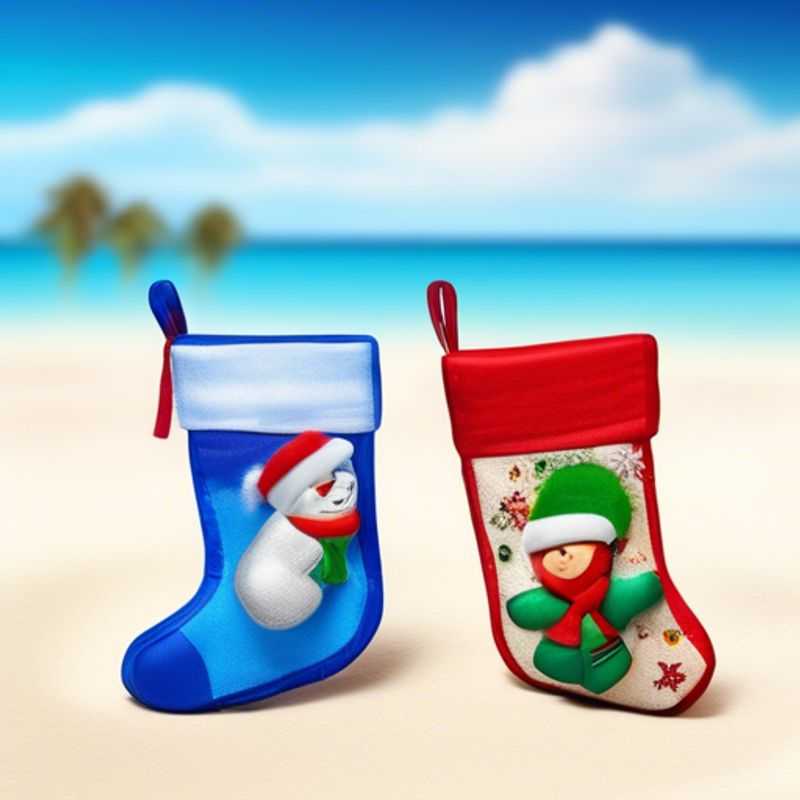7 Tips to Find Stocking Stuffers Under $1: A Bargain Hunter's Guide to Holiday Savings

7 Tips for Finding Stocking Stuffers Under $1: A Bargain Hunter's Guide
Alright, fellow bargain hunters! Stocking stuffers are a delightful tradition, but they can also be a budget-buster. Fear not, for I, your trusty shopping guru, am here to guide you on a quest for stocking stuffers under $1. Prepare to navigate the perilous aisles of dollar stores, unearth hidden treasures in thrift shops, and even harness the power of DIY!
First, let's head to the legendary dollar stores. These temples of budget-friendly wonders often hold an abundance of stocking stuffer potential. Don't underestimate the power of a simple notepad, a fun keychain, or even a pack of colorful pencils.
Next, we venture into the mystical realm of thrift stores. These havens of pre-loved goods can be surprisingly fruitful.

Hunting for Bargains: Dollar Stores, Thrift Shops, and Discount Retailers
Looking for a bargain? Dollar stores, thrift stores, and discount retailers can be your best friends! These shops often offer incredible deals on everything from household goods to clothing to toys. But, be warned, there are a few things to keep in mind when shopping at these stores. First, quality can vary. Not everything is a diamond in the rough. You may need to sift through a few items to find the gems. Second, availability can be limited. That awesome find you scored last week might be gone tomorrow. Third, be realistic about your expectations. These stores aren't known for luxury brands or top-of-the-line products. But, they're fantastic for finding everyday necessities at a fraction of the cost. Remember to check expiration dates, examine items for wear and tear, and always keep your budget in mind. Happy bargain hunting!

Don't Overpay for Trinkets: Your Guide to Online Marketplaces for Small Treasures
Online marketplaces are a treasure trove for finding small, inexpensive items. Whether you're looking for unique gifts, home decor, or just everyday essentials, these platforms offer a vast selection at competitive prices.
Here's a quick guide to navigating the world of online marketplaces for budget-conscious shoppers:
1. Explore Popular Marketplaces: Start with well-known platforms like eBay, Amazon, Etsy, and Facebook Marketplace. Each has its own strengths and specialties. eBay is known for its wide range of products, Amazon for its fast shipping and Prime benefits, Etsy for handmade and vintage items, and Facebook Marketplace for local deals.
2. Set a Budget and Stick to It: Before you start browsing, establish a clear budget for your purchases. This will prevent impulse buys and help you stay within your financial limits.
3. Utilize Search Filters and Keywords: Most marketplaces offer advanced search filters, so use them to your advantage. Narrow down your search by category, price range, condition, and other relevant factors.
4. Read Product Descriptions Carefully: Pay attention to the details provided by sellers. Check the condition of the item, shipping information, and any applicable return policies.
5. Look for Seller Ratings and Reviews: Seller feedback is a valuable resource. Check ratings and read reviews to gauge a seller's reliability and customer satisfaction levels.
6. Consider Shipping Costs: Be sure to factor in shipping costs when comparing prices. Some marketplaces offer free shipping for certain items, but others charge additional fees.
7. Use Coupons and Promo Codes: Many online marketplaces offer coupons and promo codes that can save you money. Look for these deals before you check out.
8. Remember, Patience is Key: Don't rush your purchases. Take your time to compare prices and shop around for the best deals.
By following these tips, you can effectively navigate online marketplaces and find small, inexpensive items that fit your budget and needs. Remember to always be cautious and use common sense when making online purchases.

DIY Delight: Homemade Stocking Stuffers That Will Wow
Looking for unique and heartfelt stocking stuffers? Why not consider DIY or homemade options? They offer a personal touch and can save you money, especially if you have crafting skills or a knack for creating personalized gifts.
You can find countless online resources, like Pinterest or YouTube, providing ideas for DIY stocking stuffers. Whether you're baking delicious treats, creating personalized crafts, or assembling care packages, your creativity and effort will be greatly appreciated.
To make the most of your DIY endeavors, consider your recipient's preferences and interests. For example, if they enjoy coffee, create a personalized coffee blend or a cute coffee mug holder. If they're a bookworm, put together a small book-themed gift basket with a personalized bookmark and a cozy blanket. Remember, the key is to put your heart into it!
While DIY gifts are often inexpensive, there might be a small cost associated with materials, especially if you're making something elaborate. Factor in these expenses when planning your budget, and don't hesitate to use leftover supplies or recycled materials to keep costs down.
DIY or homemade stocking stuffers are a great way to express your love and appreciation for your loved ones. With a little creativity and effort, you can create truly unique and memorable gifts. Just remember to prioritize safety when working with any tools or materials. Happy crafting!

Impulse Control: How to Stick to Your Budget and Avoid Those Sneaky Sales
Impulse purchases, those tempting grabs that suddenly appear in your shopping cart, are a notorious budget buster. But fear not, my fellow shoppers, for I, your intrepid shopping guide, am here to unveil the secrets to conquering these shopping sirens.
First, know your budget. Before you set foot in a store or click "add to cart," determine exactly how much you can afford to spend. Write it down, memorize it, and stick to it like glue.
Second, make a shopping list. This isn't just for groceries, my friend. It's for everything. List the specific items you need and resist the urge to deviate from your list. A list will keep you focused and prevent those "I need it now" moments.
Third, leave your credit cards at home. Cash is king when it comes to fighting impulse buys. You can physically see how much money you're spending, and that visual reminder helps you stay within your budget.
Fourth, shop online strategically. Websites tempt you with pop-ups, deals, and flash sales. Stay alert! Use browser extensions that block ads and disable those tempting "recommended for you" sections.
Fifth, take advantage of coupons and loyalty programs. But, only if they're for items on your list. Don't be swayed by a flashy discount on something you don't need.
Finally, wait it out. If something catches your eye, but isn't on your list, give yourself a "cooling off" period. Wait a few days before buying. If you still want it, you're more likely to be making a conscious decision.

Don't Get Shipwrecked by Shipping Costs: How to Navigate Online Shopping's Hidden Fees
Ah, the siren song of online shopping! It’s easy to get caught up in the excitement of finding the perfect item, but don’t let that excitement blind you to the hidden cost lurking in the shadows: shipping fees.
Yes, those seemingly innocuous numbers can quickly turn your bargain into a budgetary burden. So, before you click that "Buy Now" button, take a deep breath and do a quick check on the shipping costs. You’ll be surprised how much they can vary, especially depending on the size and weight of your purchase, the distance it needs to travel, and the speed of delivery you choose.
Here are a few essential things to keep in mind when deciphering the shipping costs:
1. **Free Shipping?** While tempting, "free shipping" often comes with strings attached. There might be a minimum purchase amount required, or the offer might only apply to certain items or specific regions. Look for the fine print!
2. **Shipping Options:** Be aware of the different shipping options available. Express shipping may be tempting but comes at a premium. Weigh the urgency of your purchase against the added cost.
3. **Sales Tax:** Don’t forget about sales tax! It can add up, especially if you’re making a large purchase. Some retailers may include the tax in their listed prices, while others will add it at checkout.
4. **International Shipping:** Crossing borders adds complexity and costs. Expect higher shipping fees for international purchases, plus potential customs duties and taxes.
5. **Shipping Insurance:** Consider adding shipping insurance for high-value items. It's a small price to pay for peace of mind in case of damage or loss during transit.
By taking the time to analyze shipping costs, you’ll avoid any unwelcome surprises at checkout. After all, the thrill of the hunt shouldn’t be overshadowed by a hefty delivery bill. Happy shopping!

Bulk Up Your Savings: Why Multi-Packs and Bulk Buys Are Your Budget's Best Friends
When it comes to saving money, buying in bulk can be a game-changer. Instead of grabbing single items, explore the world of multi-packs and bulk options. These larger quantities often come with a lower price per unit, meaning you get more for your money. Think of it as a treasure hunt – you're searching for the best deals and finding hidden gems in the aisles of your local store.
It's not always a straightforward adventure, though. Be careful about expiration dates – you don't want to end up with a pantry full of expired items. Also, consider storage space. If you don't have enough room to store a massive amount of cereal, it might not be the most cost-effective choice. But with a little planning and consideration, you can navigate the world of multi-packs and bulk options like a seasoned explorer.
Here are some additional tips for your bulk-buying journey:
• Know what you use. Before embarking on your bulk-buying expedition, assess your household's consumption patterns. How much of a certain item do you typically use in a month? This will help you avoid overbuying.
• Check the unit price. Don't be swayed by the bigger size – look at the price per unit (like per ounce or per pound) to compare costs and find the best deal. This is the key to discovering hidden treasures!
• Consider your needs. While bulk buying is great for staples like pasta and rice, it might not be practical for items that have a short shelf life, like fresh produce or perishable goods. Plan carefully, my friend!
By following these tips, you can unlock the secrets to saving money and maximizing your purchases. Remember, the journey of bulk buying is filled with opportunities for both savings and discovery, so embrace the challenge and enjoy the adventure!

Beyond the Shiny: Why Practicality Trumps Novelty in Everyday Life
Focusing on practical, useful items can save you money and stress in the long run. Avoid impulse buys on novelty items that might break or become obsolete quickly. Instead, prioritize items that serve a genuine purpose and will last. Consider things like high-quality tools, durable clothing, or kitchen essentials that you'll use frequently. Think about how you can get the most out of each purchase and how it will fit into your existing lifestyle. Remember that buying less, but better, will result in a more sustainable and satisfying experience.
Investing in quality over quantity is a smart strategy. High-quality items often last longer and require less maintenance. You'll spend less on replacements in the long run, saving you money and reducing waste. When it comes to practical items, focus on durability and functionality. Research the brand, material, and construction before making a purchase to ensure it will stand the test of time. A quality product will be a worthwhile investment.
Don't be afraid to ask for expert advice. Whether it's a salesperson at a local shop or a knowledgeable reviewer online, get recommendations from trusted sources. They can help you navigate the world of practical items and steer you towards choices that best suit your needs. Remember, there's a world of difference between a cheaply made item and a well-crafted one. Ask questions, compare options, and choose wisely.
Remember, a thoughtful and curated approach to shopping is key. Focus on the value and function of each item, not just its novelty or aesthetic appeal. Practical items often come with a cost, but the investment is worth it. These items will serve you for years to come, providing you with practical solutions and long-lasting satisfaction. So, the next time you shop, remember to prioritize the practical, useful items that will make your life easier and more fulfilling.
